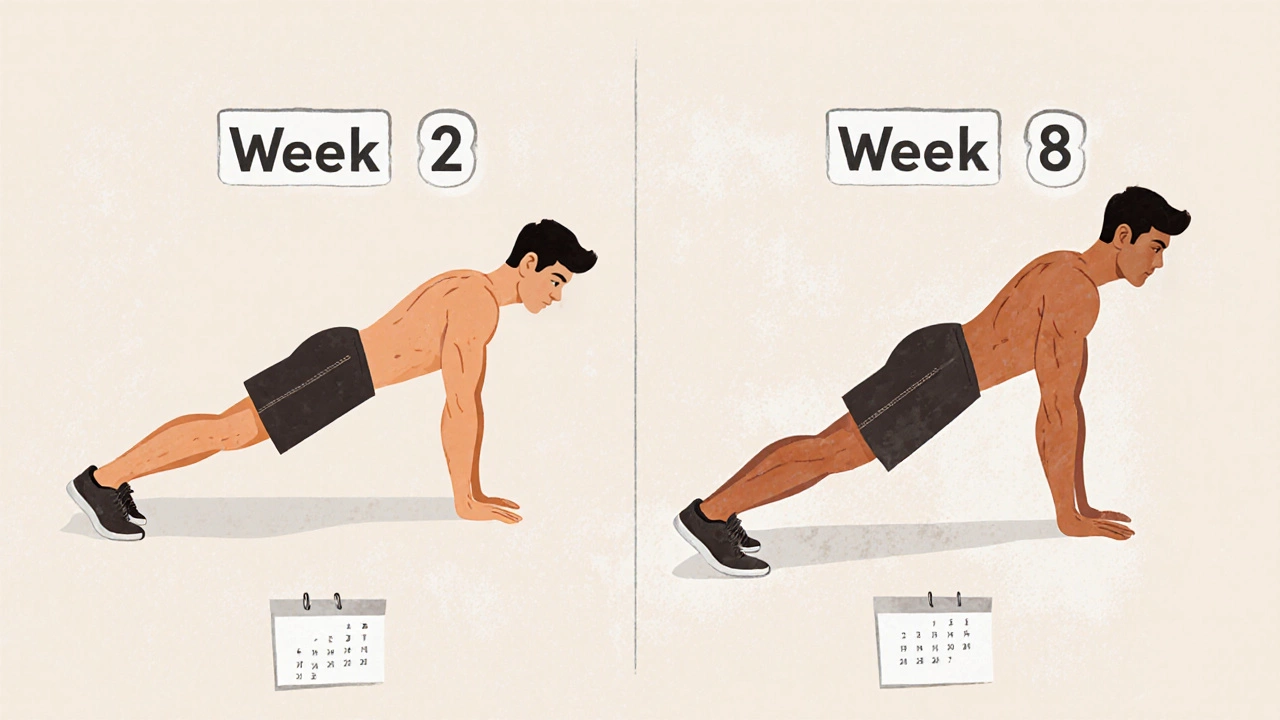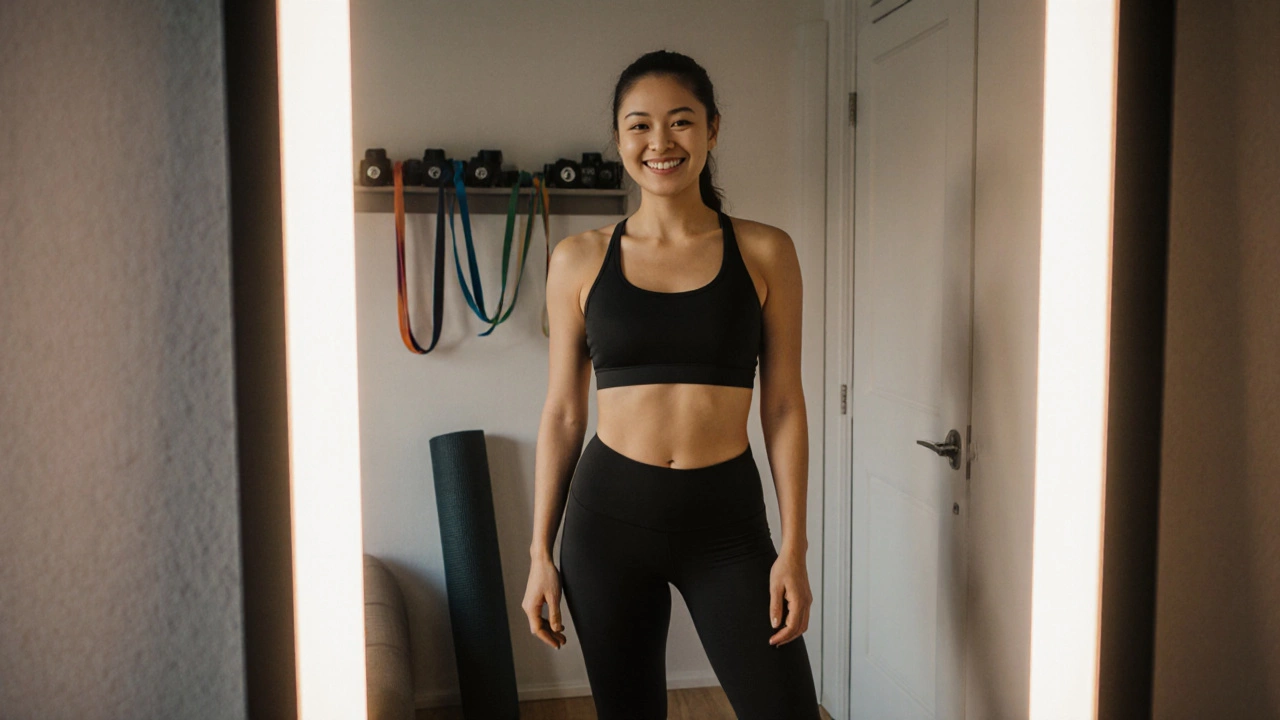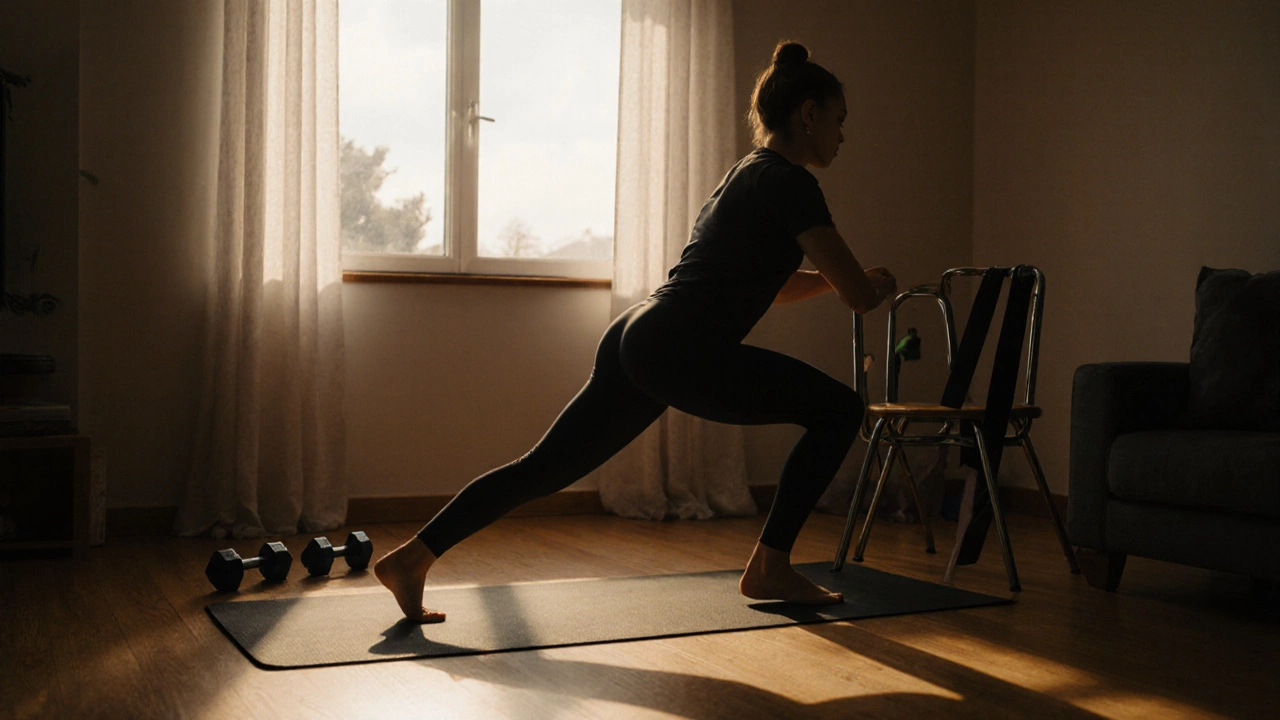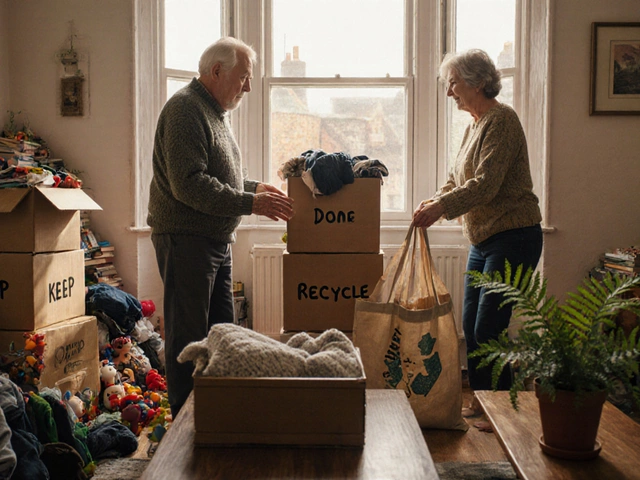People ask how long it takes to get in shape like it’s a race with a finish line. But getting in shape isn’t about hitting a number on the scale or squeezing into jeans from five years ago. It’s about building strength, endurance, and habits that last. And if you’re working out at home with basic equipment, you need to know what’s real - not what Instagram influencers sell.
What Does ‘In Shape’ Actually Mean?
‘In shape’ means different things to different people. For some, it’s being able to climb stairs without gasping. For others, it’s doing 10 push-ups in a row or holding a plank for a full minute. For most, it’s feeling stronger, moving easier, and having more energy through the day. That’s not about abs. It’s about function.
Realistic fitness goals don’t require a gym membership or expensive gear. A pair of dumbbells, a resistance band, and a yoga mat are enough to start. You don’t need a Peloton. You don’t need a home gym. You just need consistency.
The First 2 Weeks: Getting Used to Moving
Week one is messy. Your muscles ache. Your motivation wobbles. You forget to warm up. You skip a day and feel guilty. That’s normal.
By week two, you start noticing small wins: you slept better. You didn’t reach for snacks at 3 p.m. You finished your workout without stopping. These aren’t dramatic, but they’re the foundation. Your body is learning how to move again. Your nervous system is waking up.
If you’re doing 20-30 minutes of bodyweight exercises three times a week - squats, push-ups, lunges, planks - you’re already ahead of 80% of people who say they want to get fit. The key isn’t intensity. It’s showing up.
Weeks 3-8: Building Real Strength and Endurance
This is where most people quit. Not because they’re weak. But because they expected to see visible changes by now. You might not look dramatically different, but your body is changing underneath.
By week six, you can do more reps. Your push-ups are cleaner. You hold a plank longer. Your shoulders don’t hurt when you reach for a high shelf. Your legs feel steadier when you walk uphill. That’s progress.
If you’ve added light dumbbells - even 5- or 10-pound ones - you’re building muscle. Muscle doesn’t show up overnight. But it starts growing around week four. And by week eight, you’ll notice your clothes fit differently. Not because you lost weight, but because you gained lean mass. Muscle is denser. It takes up less space.
A 2023 study from the University of Sydney tracked 200 people doing home-based strength training three times a week. After eight weeks, participants increased their strength by an average of 32%. No gym. No personal trainer. Just consistent effort.
Months 2-4: The Transformation Phase
Now you’re not just moving better - you’re starting to look different. Your arms have definition. Your core feels tighter. Your posture improves. You catch yourself standing taller without thinking about it.
This is when people say, ‘I finally feel like I’m in shape.’ And they’re right. But here’s the catch: you didn’t get here by doing 100 crunches a day. You got here by doing squats, deadlifts, rows, and push-ups - compound movements that work your whole body.
If you’ve stuck with it, you’re burning more calories at rest. Your metabolism is rising. You’re sleeping better. You’re less stressed. These aren’t side effects. They’re the point.
At this stage, your home workout setup matters more than ever. A good set of adjustable dumbbells (like Bowflex SelectTech or similar) lets you scale resistance without buying five pairs. A sturdy resistance band adds tension for glutes and back. A yoga mat keeps your joints safe. That’s it. No fancy machines. No subscriptions.

Month 5 and Beyond: Maintenance, Not Magic
After five months, you’re not ‘done.’ You’re just getting started. Getting in shape isn’t a destination. It’s a lifestyle.
You’ll have days when you don’t feel like working out. That’s fine. You don’t need to be perfect. You just need to be consistent. One 20-minute session a week keeps you connected to your progress. Two sessions keep you growing.
People who stick with home workouts for a year report better mental health, fewer aches and pains, and more confidence than those who quit after three months. The real win isn’t the six-pack. It’s knowing you showed up for yourself, even on the hard days.
What Slows Progress Down?
Here’s what actually stops people:
- Expecting results in two weeks
- Skipping rest days
- Not eating enough protein
- Doing only cardio and ignoring strength
- Comparing yourself to someone with a trainer, supplements, and a 40-hour workweek
Protein intake matters. Aim for 0.7-1 gram per pound of body weight. If you weigh 150 pounds, that’s 105-150 grams a day. Eggs, chicken, beans, Greek yogurt - these are your friends.
Rest days aren’t lazy. They’re when your muscles repair and grow. Take at least one full rest day a week. Walk. Stretch. Breathe.
Home Workout Equipment That Actually Helps
You don’t need a lot. But the right tools make a difference:
- Adjustable dumbbells - Replace five pairs. Save space. Save money.
- Resistance bands - Great for glutes, shoulders, and rehab work. Under $20.
- Yoga mat - Protects your spine and knees. Look for one with good grip.
- Sturdy chair or bench - For step-ups, triceps dips, elevated push-ups.
- Timer or app - Keeps you on track without staring at a clock.
That’s it. No treadmill. No cable machine. No $2,000 home gym. Just you, your body, and a few smart tools.

Realistic Timeline Summary
Here’s what you can expect if you train 3-4 times a week with basic equipment:
- Weeks 1-2: Better energy, improved sleep, fewer cravings.
- Weeks 3-8: Noticeable strength gains, clothes fit better, posture improves.
- Months 2-4: Visible muscle tone, increased endurance, reduced joint pain.
- Months 5-12: Sustainable fitness. You don’t think about working out - you just do it.
No magic. No shortcuts. Just time, consistency, and patience.
What If You Don’t See Results?
If you’ve been consistent for three months and feel stuck, check these:
- Are you eating enough protein?
- Are you increasing resistance? (Try adding a rep, a set, or heavier dumbbells)
- Are you sleeping 7+ hours most nights?
- Are you stressing too much? (Chronic stress blocks fat loss and muscle growth)
Progress isn’t always linear. Some weeks you’ll feel strong. Others, you’ll feel flat. That’s normal. Keep going.
Can you get in shape with just bodyweight exercises?
Yes. Bodyweight training builds strength, endurance, and muscle if you progressively challenge yourself. Adding reps, slowing movements, or using elevated surfaces (like a chair for push-ups) increases difficulty. Many athletes and military personnel rely on bodyweight workouts for years.
How often should I work out at home to see results?
Three times a week is enough to build strength and see changes. Four times is better if you’re aiming for faster results. But even two solid sessions a week will keep you moving forward. Consistency beats frequency every time.
Do I need to diet to get in shape?
You don’t need a strict diet, but nutrition matters. Eating enough protein helps your body rebuild muscle. Cutting back on sugar and processed foods gives you more energy and reduces bloating. Focus on whole foods - not calorie counting.
Is it possible to get in shape without equipment?
Absolutely. Many people start with just a yoga mat and their body weight. Squats, lunges, push-ups, planks, and glute bridges are powerful. You can build serious strength without dumbbells. Equipment just makes it easier to keep progressing.
Why do some people get results faster than others?
Genetics, starting fitness level, sleep, stress, and diet all play a role. Someone who was active before will see changes faster than someone starting from zero. But everyone can improve. Speed doesn’t matter. Progress does.
Final Thought: It’s Not About Speed - It’s About Staying
Getting in shape isn’t a sprint. It’s a slow, steady walk you take every day. Some days you’ll walk fast. Other days you’ll barely move. But as long as you keep walking, you’re going somewhere.
You don’t need to be perfect. You just need to be persistent. The equipment you have is enough. The time you have is enough. You are enough - right now, today, as you are. And in six months? You’ll be someone you’re proud to see in the mirror.







